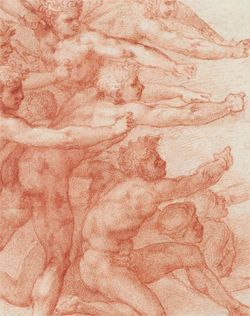On loan to The Met The Met accepts temporary loans of art both for short-term exhibitions and for long-term display in its galleries.
Cupid
Michelangelo Buonarroti Italian
The iconography of this idealized youth makes him difficult to identify. Like Cupid, he has a quiver but there is no sign he ever had Cupid’s traditional wings. The statue is first recorded in 1556 at the house of Jacopo Galli in Rome, where the work is identified as Apollo. Galli is known, however, to have owned a Cupid sculpted by the young Michelangelo. So it is significant that by 1650, when the figure occupied a garden niche at the Villa Borghese, Rome, he had been retitled Cupid. By 1902 the sculpture was gravely damaged. Nonetheless the dealer Stefano Bardini recognized it as Michelangelo’s work when he offered it at auction in London, but this attribution was soon forgotten or discounted. It was later purchased by the architect Stanford White and installed on a fountain at the Fifth Avenue mansion of Mr. and Mrs. Harry Payne Whitney, today the office of the Cultural Services of the French Embassy in New York, where only recently it was recognized as Michelangelo’s lost Cupid.
This image cannot be enlarged, viewed at full screen, or downloaded.
This artwork is meant to be viewed from right to left. Scroll left to view more.



















